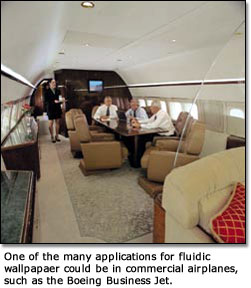| Sound-stealthy wallpaper
Boeing scientists are working to eliminate
unwanted noise with an active wall coating that uses compressed air
BY WILLIAM COLE

 Imagine
a high-tech "wallpaper" that uses compressed air to block out
noise in a commercial or military airplane, protect sound-emitting military
equipment from detection in the field, or shield sensitive satellites
from deafening rocket sounds. Imagine
a high-tech "wallpaper" that uses compressed air to block out
noise in a commercial or military airplane, protect sound-emitting military
equipment from detection in the field, or shield sensitive satellites
from deafening rocket sounds.
Such a solution is not so off-the-wall.
Scientists at Boeing are working on a technology that could actively suppress
unwanted noise inside airplanes and even make life more comfortable for
astronauts in space. The technology called "fluidic wallpaper"
has many potential applications for protection, privacy and stealth.
Anders Andersson, a Technical Fellow at Phantom Works in Seattle, said
the system promises to be "a breakthrough in acoustics technology."
The quarter-inch-thick wallpaper is an active-control system using "smart"
materials. It employs compressed air to counterbalance oscillating pressures
that make up low-frequency noise. Low-frequency sound is emitted by such
commonplace systems as propellers, jet engines, and heavy-duty diesel
engines, and is easily transmitted through walls and windows. Reducing
aircraft engine low-frequency noise has traditionally commanded heavy-weight
solutions — layers of sound-suppression materials that give the vehicles
unwanted pounds and cost.
Fluidic wallpaper weighs much less than traditional materials, takes up
less space and can be produced inexpensively. The compressed air used
within the wallpaper is generated by aircraft engines or air conditioning
and does not require electrical power.
The wallpaper is projected to be unmatched by any other concept in its
low-frequency noise performance, said Andersson.
"We're still in the development stages and there's a lot more testing
to be done," said Andersson, who is helping Boeing Commercial Airplanes
in its efforts to control noise aboard commercial jetliners. But he already
foresees plenty of other applications.
Fluidic wallpaper could be used, for example, as wall trim in commercial
airplanes, and in executive airplanes and military transports to satisfy
command-post communication and stealth requirements. It could muffle the
noise of armored vehicles and improve communication and the quality of
life for astronauts aboard the International Space Station. The system
could be built into equipment tarps that would shield the outside world
from noisy generators and other equipment and prevent their detection
in military operations. It could be used also to line rocket fairings
to protect sensitive satellite payloads from the effects of noise generated
by a launch.
Andersson said, "There is potential for building a whole industry
around this concept."
|